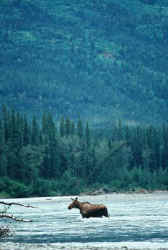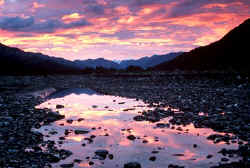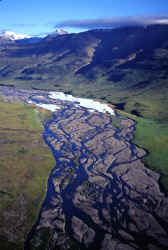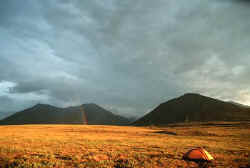|
“This area [the Anaktuvuk River Valley] is a traditional hunting ground of the Nunamiut people, [perhaps] the last nomadic people in the United States,” says Rennicke. “There are many piles of caribou antlers and bones strewn across the valley floor—it’s a valley of bones.” This caribou skull with antlers was discovered along the banks of the Anaktuvuk River.
|
Built by Noel Wien梐 famous Air Alaska bush pilot梚n 1948, this lodge receives about 1,500 visitors per year. Wald took this photograph at sunset, which in late July is around midnight (in the summer, there is continuous light for at least 30 days). Located in the village of Bettles, the lodge is 18 miles (29 kilometers) from the park and is the only established accommodation in the area.
|
While hiking through the narrow Ernie Creek gorge, a popular bear haunt, Rennicke calls out to make the group抯 presence known. Grizzly and black bears live in the park and are hard to detect in thick patches of brush. (Bears pose little threat to hikers unless they are startled or cornered.) Wald adds, “Their presence alters the landscape梞akes it alive, more primal.”
|
 |
 |
 |
| Rennicke recalls a
close encounter with a moose while rafting in the Koyukuk River
(pictured above): “We came face-to-muzzle with a moose halfway
across the river. The current was very strong there and it was
hard for us to slow down. For a few seconds it looked as though
it would carry us directly into the moose, head-on. But the
moose stomped out of the river and disappeared in the
alder.” |
Sunlight streams through thinning storm clouds as Rennicke scoops up a drink of water from the pristine Koyukuk River. “Jeff was just glowing in the light,” Wald says. “All the surrounding peaks lit up too, and for about ten minutes I just went crazy shooting.”
|
After days of rain, the sun finally emerged to illuminate a gravel bar and puddle between Boreal Mountain and Frigid Crags—peaks that form the “gates” of the Arctic. “This is one of those shots photographers look for to express the beauty of the place,” remarks Wald. |
 |
 |
 |
| “This area [along the Anaktuvuk River] was beautifully blue, like candy, and with all the little streams flowing across it, the air was filled with sounds of trickling water,” recalls Rennicke. “But there was also danger. We were sliding and splashing across it [the ice shelf] like kids when suddenly, THHHHHHUMP—a huge section of it collapsed right in front of us and smashed into the creek below to be rushed away by the strong current.” |
Rennicke and guide Carol Kasza stumble upon an open field during a strenuous, five-mile (eight-kilometer) hike over the North Fork of the Koyukuk River: “It was magical梩he black, burnt stumps, red flowers, green grass, and blues and whites of the mountains in the background,” says Rennicke. “A moment of utter beauty right in the middle of nowhere.” |
“This was my first camp outside of the village of Anaktuvuk Pass,” says Wald. “Carol Kasza [our guide] and Jeff arrived the next day, but I wanted to spend one day in the village. At dawn there was a little rain squall and I peeked out my tent to see this rainbow.”
|
| Photograph by Beth Wald |
| www.nationalgeographic.com/ |